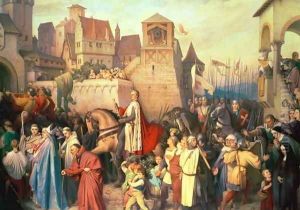Josef Mathias Trenkwald Paintings
Josef Mathias Trenkwald was an Austrian painter and illustrator, known for his historical and religious compositions, born in 1844 in Vienna, Austria. His artistic journey commenced at the Academy of Fine Arts Vienna, where he was influenced by the Romantic and Neo-Renaissance movements, prominent in the European art scene of the 19th century. Trenkwald's education and early work reflected the academic rigor and classical foundations that were characteristic of the Academy, laying the groundwork for his later achievements.
After completing his studies, Trenkwald's career took a path that was both diverse and reflective of the artistic trends of his time. He became particularly noted for his murals and frescoes, which adorned various public and ecclesiastical buildings across the Austro-Hungarian Empire. His work was marked by a meticulous attention to detail, a profound sense of historical accuracy, and a deep reverence for religious iconography, which resonated with the sensibilities of his contemporaries.
Among Trenkwald's most significant works were his contributions to the decoration of the Votive Church in Vienna, a project that underscored his mastery in handling large-scale compositions and his ability to imbue his subjects with a sense of spiritual depth and solemnity. His illustrations also gained recognition, particularly those that depicted scenes from Austrian history and folklore, showcasing his versatility and his keen interest in the cultural heritage of his homeland.
Despite his success, Trenkwald remained a relatively private figure, dedicating himself to his art and his teaching responsibilities. He was also involved in the artistic community of Vienna, contributing to the development of the arts in the late 19th century. Josef Mathias Trenkwald passed away in 1897, leaving behind a legacy that, while perhaps not as widely recognized as some of his contemporaries, reflects the richness and diversity of Austrian art at the time. His works continue to be studied and admired for their historical significance and artistic merit.
